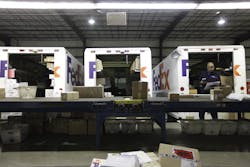You see it almost every day now in the online retailing world, advertised usually in big, bold letters: free shipping.
Indeed, Walmart just through the gauntlet down in its battle against Amazon Prime by waiving its $50 rule for the next month.
And if you didn’t suspect it already, all of this “free shipping” promotion when it comes to e-commerce creates a huge trickle-down impact on trucking – especially when heavier goods, such as furniture, get involved.
That’s not going to subside anytime soon, by the by; indeed, in one new report compiled by global consulting firm Accenture, not only will e-commerce demand for “free delivery” keep increasing, more time-specific services may be needed to attract and keep the loyalty of ever more fickle consumers.
“Today, eTailers [Editor’s note: that’s a term denoting ‘a retailer selling goods via electronic transactions on the Internet’] are chasing a rapidly expanding market, in which delivery is becoming a critical differentiator and a strategic priority,” noted Brody Buhler, who leads Accenture’s global post and parcel business, in the firm’s Differentiating Delivery: How to Win the eCommerce Battle study. “There is no doubt that eTailers are getting strategic about delivery and so should parcel delivery organizations.”
That study, based on a survey of 1,124 small- and medium-sized businesses across 10 countries and five continents, found that delivery impacts all stages of a consumer’s buying process, increasing the pressure on retailers to provide a seamless online process to purchase and return products.
For example, Buhler noted that two-thirds (66%) of online consumers now chose a retailer based on the number of delivery options, with another three-quarters (76%) looking at a retailer’s return policy before completing an order.
That’s not all, though. As we’ve seen with Amazon’s foray into the logistics world, many “eTailers” are now creating their own delivery networks in order to meet customer demands (with at least one firm predicting Amazon could make even bigger waves in the supply chain world down the road.)
“Not only are marketplaces moving into the delivery space, but major retailers are now sidestepping delivery providers in favor of their own services,” Buhler said in Accenture’s study.
“Digital is dramatically blurring the boundaries between eTailers, marketplaces and delivery providers,” he stressed. “Adapting to these new threats as well as new opportunities is not only urgent but critical to future growth of parcel organizations.”
Accenture believes there are five areas delivery companies need to focus on in order to, in Buhler’s words, “remain competitive” within a rapidly changing global eCommerce market:
- Keep customers happy with more services: Globally, a majority (79%) of Accenture’s survey respondents said that easy and affordable returns services together with full visibility tracking are the most important features to offer. New services of greatest interest to eTailers include allowing customers to determine when they want their packages delivered (69%); delivery notification on the day of delivery (67%); ability to coordinate delivery directly with the provider, not the eTailer (68%).
- More return options needed: Accenture’s research found that consumers want better return options services and would shop more with an eTailer that made returns easy. eTailers placed return capabilities among the most important criteria when evaluating a delivery provider.
- The pricing of shipping services is key: The study found eTailers are sensitive about the price of shipping packages, with thee top reason eTailers stay with one transportation provider (some 73% of respondents) is to consolidate volume to secure the best discount on price. Accenture recommends that delivery firms should test volume discount levels to make sure they offer terms that promote eTailer exclusivity or primary provider status and that the right digital tools, particularly analytics, can help determine smart pricing decisions.
- Yet demand for more services will increase: As eTailers grow bigger, the complexity and diversity of services they require increases rapidly, Accenture found. Larger eTailers are significantly more interested in services like warehousing and fulfillment or onsite installation of purchases than smaller businesses. While basic delivery services are sufficient to capture smaller businesses, more robust features will be necessary to help these businesses as they grow. “Properly segmenting customers to develop targeted products to address specific needs are essential to winning the price and feature battles,” Buhler said.
- Make cross-border shipments easier: Delivery companies need to customize their offerings for cross-border, business-to-consumer e-commerce; a market which is projected to grow to $994 billion by 2020. New “cross-border shoppers” have different needs and expectations, noted Buhler, including predictable delivery dates and costs. Providers that ensure seamless, simplified and reliable international delivery services will quickly become the primary and preferred provider that eTailers seek.
Whether or not trucking firms like this whole idea of helping eTailers offer “free shipping” services, Accenture’s research found that there seems to be a wide open playing field in terms of provider opportunities.
More than one-quarter of the eTailers responding to the firm’s survey (26%) said they use at least three parcel providers to ensure the best price and to mitigate the risk of lost packages or delayed delivery that might result from relying on a single provider.
And despite the possibility of one transportation provider handling all of their required services, a majority of eTailers (79%) said they still would prefer working with multiple providers.
That’s nothing to sniff at, for there’s a lot of freight to be found in the e-commerce world. Indeed, according to the 2015 Worldwide Retail Ecommerce Report from eMarketer, retail e-commerce is projected to account for 7.3% of the total 2016 retail market worldwide – a 25% increase from 2014 – and keep right on climbing to 12.4% by 2019.
But can truckers make decent money handling such cargoes, especially within that “free shipping” context? That’s a big question that needs answering.

